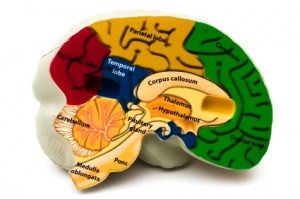Test your Short-Term Memory: How many letters can you memorize?
 Memory is more complex that we usually think. Cognitive sciences have identified different memory systems, each supported by different brain regions. One major difference is between long-term and short-term memory (also called working memory).
Memory is more complex that we usually think. Cognitive sciences have identified different memory systems, each supported by different brain regions. One major difference is between long-term and short-term memory (also called working memory).
Long-term memory is an unlimited storage of memories dating as far back as you can remember to a few minutes ago. For instance, when you remember your first day in high-school or what you said to your colleague two minutes ago, you are using your long-term memory system. This system depends mostly on parts of the temporal (in blue here) and frontal (in green) regions of the brain.
Short-term or working memory is a limited storage used to briefly keep the information needed for the task at hand. For instance, when you keep in mind a phone number while you are dialing it or when you do some mental calculation you are using your working memory system. This system depends mostly on parts of the frontal (in green) and parietal (in yellow) regions of the brain.
Working memory is crucial for most of the tasks we perform daily. It is also quite vulnerable to the aging process. Two good reasons to try to maintain this function! Ready to test and sharpen your short-term memory?
Follow this link to memorize series of letters. The first 2 trials are very easy but the test gets quite challenging after that!


